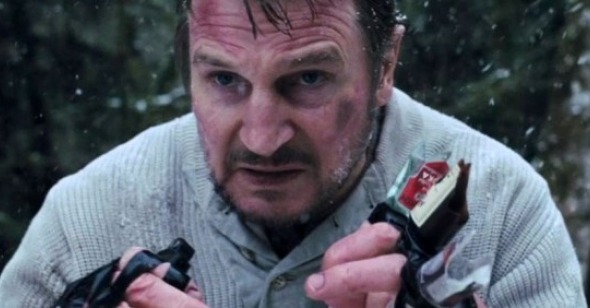Monday Hangover:
The Grey
By Adam Nayman and Jeff Reichert
Liam Neeson has a very particular set of skills, skills he has acquired over a very long career. These include being an authentic hulk: before he worked with Steven Spielberg and Atom Egoyan, he did background-brute duty in Krull and The Delta Force. He’s thus ideally cast in The Grey as a grizzled warrior-type, rallying the survivors of a horrific plane crash out in the Alaskan wilderness. Watching the star’s long, solid body slicing purposefully through the snow while his fellows lag behind leaves little doubt about who’s the man—though the fact that the next biggest star in the cast is Dermot Mulroney doesn’t hurt Neeson’s alpha-male status.
The top-dog metaphor is made literal when the group runs up against a pack of hungry wolves; fortunately, Neeson’s character—an oil worker/soldier of fortune type named Ottaway—is an expert in lupine behavior, as well as in the best ways to keep them at bay and eventually kill them. If The Grey is entertaining for good, long stretches, it’s mostly because of Neeson’s credibility as a guy who can start fires from scratch in subzero temperatures and craft awesome wolf-killing weapons from sticks and shotgun shells. He’s like MacGyver but way, way more soulful.
Too soulful, in fact. When The Grey finally trips up, after about an hour’s worth of well-executed outdoor-adventure-movie moves (kudos to DP Masanobu Takayanagi for his muscular camera moves and gray-scale palette), it’s on its own attempts at profundity. As the numbers in Ottaway’s party decrease, the survivors are increasingly moved to contemplate their own mortality, leading to lots of sensitive-bro conversations that sound less like the spontaneous reflections of traumatized men than the deep thoughts of filmmakers using them as their frostbitten mouthpieces. This being Joe “A-Team” Carnahan’s first sustained stab at anguished masculinity—notwithstanding a couple of maudlin longueurs in the brain-dead Tarantino pastiche Smokin’ Aces—one might be inclined to give points for effort, except that it’s the burden of would-be seriousness that breaks this solidly built film’s back. Neeson’s got maybe the broadest shoulders in Hollywood, but even they can’t hold up the scene where Ottaway bellows his existential angst to the heavens: the point at which he actually said he was looking for a sign was when I started looking at my watch. —AN
Adam, wasn’t it a little less than a year ago that we launched this column discussing the much superior Neeson-starring Unknown? (Shall we make it a habit and meet back here in a few weeks for Battleship?) Unlike Carnahan, Jaume Collet-Serra clearly knows what his audiences want and how best to deliver the goods. Poor Joe somehow convinced himself that what audiences really wanted out of The Grey, more than the spectacle of burly Liam Neeson in a cap and ribbed sweater punching wolves in the face, was a snowbound meditation on what drives men to continue living in the face of adversity or some such other nonsense.
The second hour of The Grey does indeed inexplicably mire itself in angsty masculine-existential-spiritual pabulum, proof positive that in the world of would-be stripped-down thrillers, less is almost always more. I entered the theater with an extremely low bar for total gratification: wolf-punching. How is it that, after nearly two hours of movie, I exited wholly unsatisfied on that score, yet felt overburdened with thoughts of mortality and humanity’s insignificance in the face of nature, or at least hungry timberwolves? Perhaps, in the not-too-distant past (maybe as research for this film), Carnahan attended a fifth-grade English class where he was educated about the essential dramatic conflicts: man vs. man, man vs. nature, man vs. self. All well and good for a narrative artist to understand the fundamentals, but why, oh why, did he feel the need investigate them all, at length, within the confines of such a beautifully simple scenario?
Collet-Serra probably wouldn’t have made similar missteps. Instead of Neeson bellowing at a wrathful invisible God, he’d have him drink blood from a freshly severed wolf head as if it were the furriest, most awesome chalice around. Instead of a lengthy scene in which one of Neeson’s compatriots, exhausted from the journey, decides to lie down and accept his fate (the remaining men glumly acknowledge his choice with handshakes and furrowed brows), Collet-Serra might have instead had the man put down like Old Yeller, for comic effect, of course. The takeaway for Joe Carnahan on this is simple: Don’t over-think it on the next one, buddy. —JR
